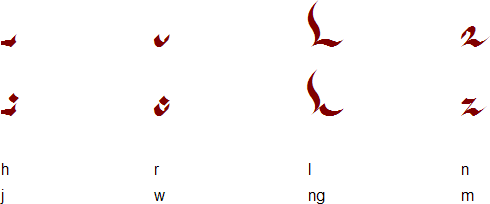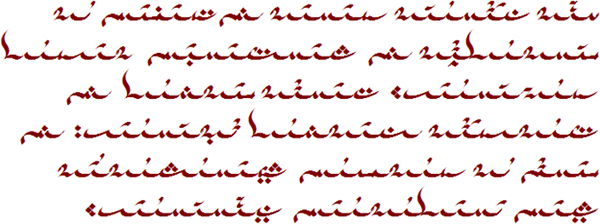h1>Sadhain
![]()
Sadhain is yet another alphabet created by the people in Dardaniell,
the fictional world invented by Pieter Rottiers. Sadhain actually is no
Dardain word, its name is a distortion of the name of the inventors girlfriend
(whom he loves very much, of course!). It is a fully vocalized abjad, and
like most abjads it is written from right to left. The script is used to
write Dardain.
Sadhain alphabet
Hard consonants: plosives and fricatives
In Sadhain there are no more than four different characters to cover this
section. Instead, a whole variety of dots are used to distinguish them.
Every family of hard consonants has a basic form (no dots), a sonorized form
(one dot), a fricative form (two dots) and a form that is sonorized as well
as fricative (three dots).

Soft consonants: sonorants
Sonorants are those consonants that are voiced and can never be made voiceless,
and that can be produced continuously at the same pitch. In Sadhain these are
seperated in four subgroups: nasals (m, n and ? ), liquids (l and r), semi-vowels
(j and w) and the h.

Vowels
As said before, Sadhain is a fully vocalized abjad. This means that vowels can
be added to the script as diacritics. Every vowel is added on a seperate carrier,
that is fixed to the other letters. Vowels also have certain similarities: ‘e’ is
actually a combination of ‘a’ and ‘i’, ‘u’ is a combination of ‘o’ and ‘y’, and
the last three vowels are nothing more than the 180 degrees shift of the first
three. A seperate vowel is the letter for schwa (ə), which is the symbol
for the unstressed and toneless neutral vowel that sounds like the ‘a’ in about.

Punctuation

Sample text in Sadhain

Transliteration
run’daerion saran hwi shaiar in hornilën hwi dharcharàr nasil
simoriat. Tharen hanwil hwi chinsaen danwil ennoriat, hwi ‘hare in sinhir
bhfaridhinain dthar araliniar dturoriat.
Translation
All human beings are born free and equal in dignity and rights. They
are endowed with reason and conscience and should act towards one another
in a spirit of brotherhood.
(Article 1 of the Universal Declaration of Human Rights)
